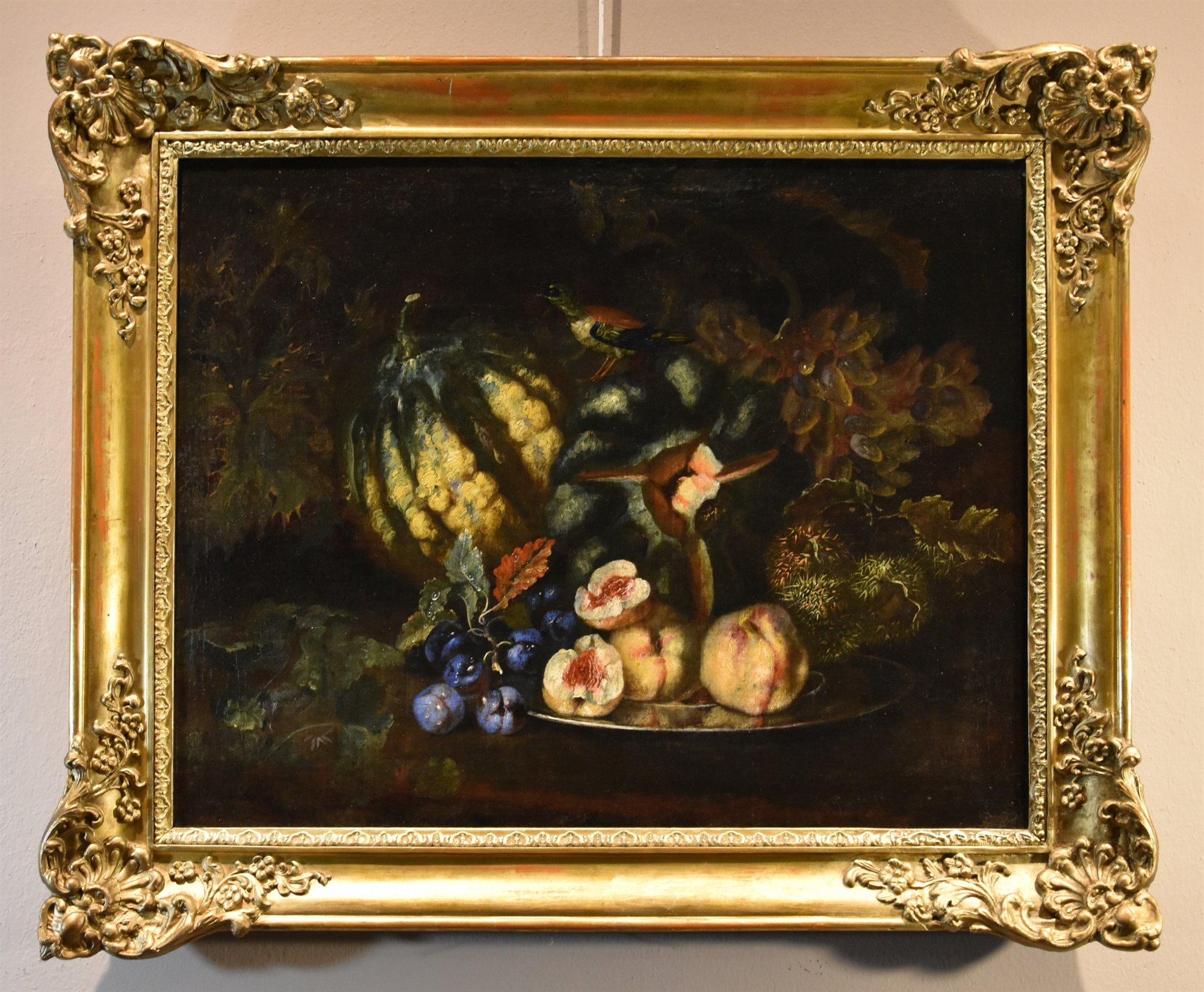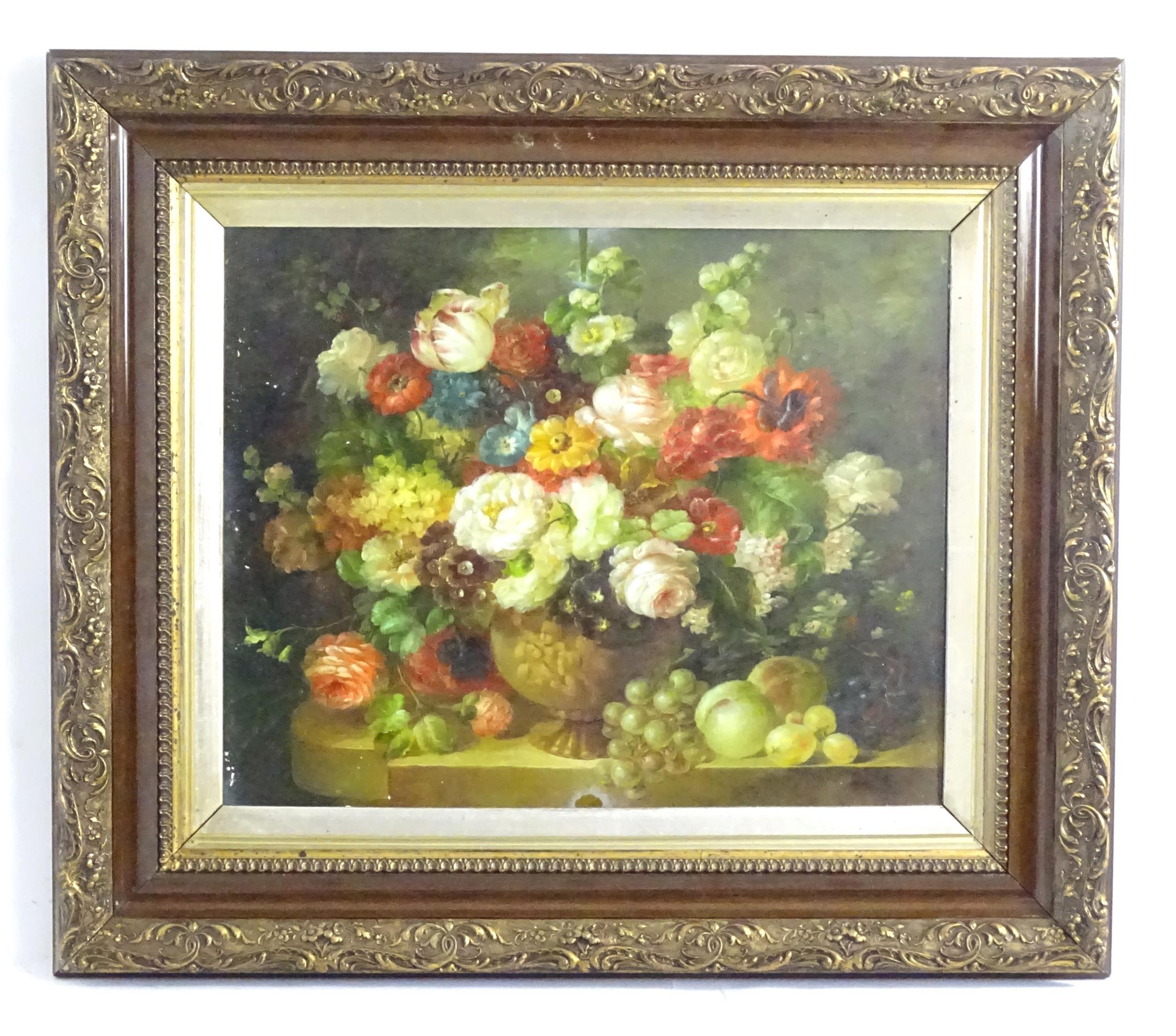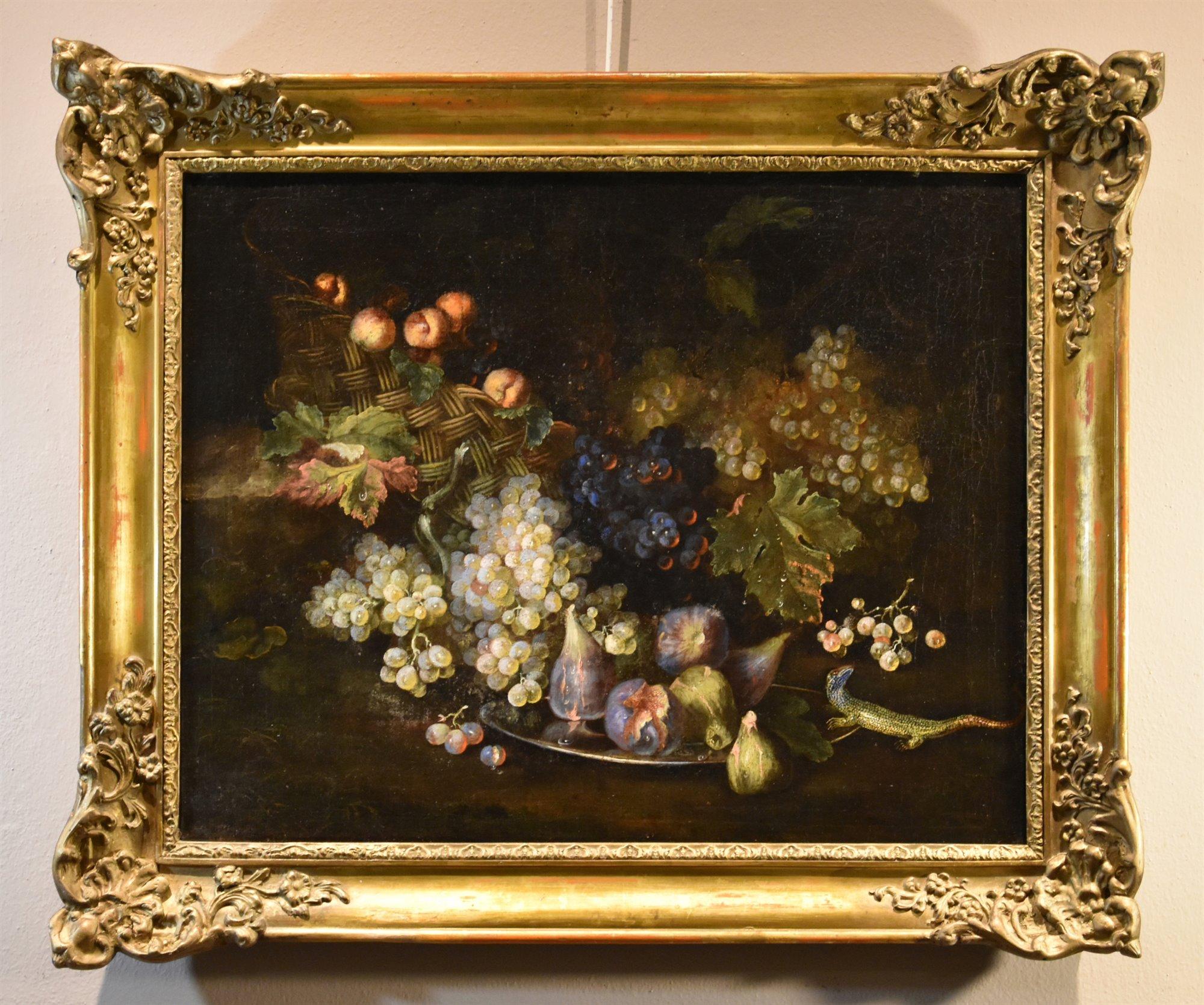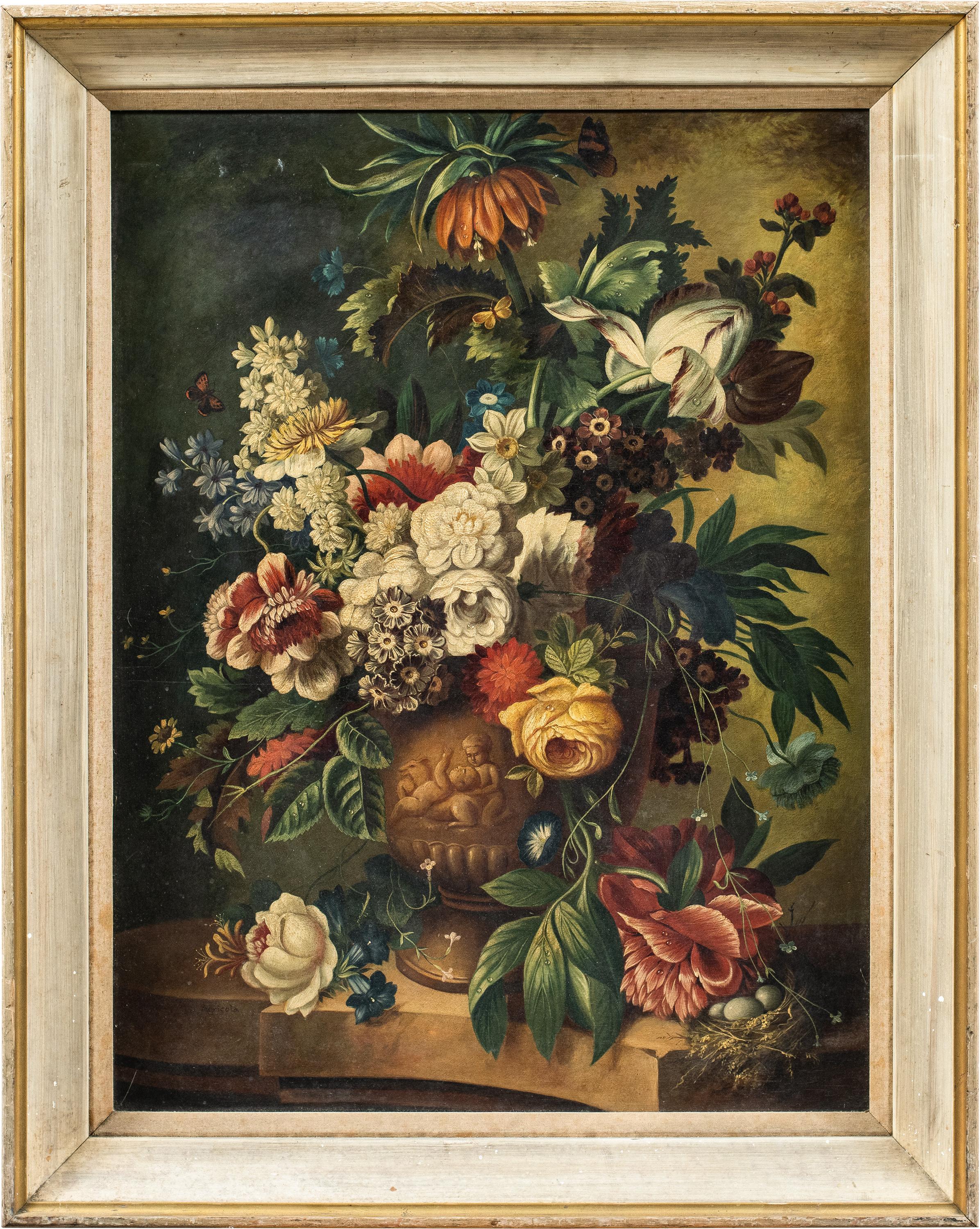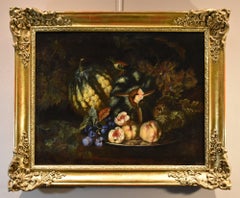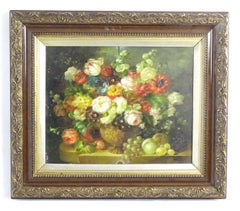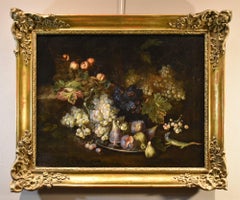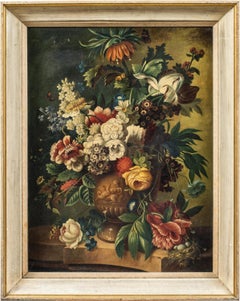Items Similar to Fruit & Flower Garland round Intaglio of Putti - Old Master floral oil painting
Want more images or videos?
Request additional images or videos from the seller
1 of 22
Fruit & Flower Garland round Intaglio of Putti - Old Master floral oil paintingCirca 1780
Circa 1780
$10,969.23
$13,711.5420% Off
£8,000
£10,00020% Off
€9,330.23
€11,662.7920% Off
CA$15,020.63
CA$18,775.7920% Off
A$16,700.90
A$20,876.1220% Off
CHF 8,720.29
CHF 10,900.3620% Off
MX$203,290.56
MX$254,113.2120% Off
NOK 111,267.05
NOK 139,083.8220% Off
SEK 104,251.91
SEK 130,314.8920% Off
DKK 69,633.23
DKK 87,041.5320% Off
Shipping
Retrieving quote...The 1stDibs Promise:
Authenticity Guarantee,
Money-Back Guarantee,
24-Hour Cancellation
About the Item
This superb German Old Master still life oil painting is attributed to circle of Johann Amandus Winck and also shows the influences of the Dutch Old Masters. Painted circa 1780 the painting depicts a delicate garland of fruit and flowers surrounding a white Trompe l'oeil classical female figure and two putti. The garland consists of ivy, morning glory, roses and daffodils at the top and grapes, plums, peaches and pears at the bottom along with several insects including a beautiful moth. The details and depiction of the different textures are superb. This is a beautiful painting showing the influence of the Dutch Old Masters such as Huysum and Horemans and has excellent provenance.
Provenance. The Collection of John Bouverie (d. 1750), thence by descent to his wife
Anne Bouverie (d. 1757), thence by descent to her brother
John Hervey (d. 1764), thence by descent to his son
Christopher Hervey (d. 1786), thence by descent to his aunt
Elizabeth Bouverie (d. 1798), by whom bequeathed to
Sir Charles Middleton, later 1st Baron Barham (d. 1813) and thence by descent through the present owner's family.
Condition. Oil on canvas, 26 inches by 20 inches and in good condition.
Frame. Housed in an ornate gilt frame, 33 inches by 27 inches, in good condition.
Johann Amandus Winck (1748-1817) ranks as one of the leading German still-life painters of the late eighteenth and early nineteenth centuries. He began his artistic training under his father, Johann Chrysostomus Winck (1725-95), who was court painter to the Prince-Bishopric of Eichstätt. Johann Amandus continued his studies in Munich under his uncle, Thomas Christian Winck (1738-97), court painter and official scene painter to the Electorate of Bavaria. As early as 1777 Johann Amandus produced four Gobelin designs for the Bavarian Court – a commission he almost certainly owed to his uncle’s influence at court. In the 1790s, uncle and nephew are known to have worked together on the completion of a fresco scheme. Winck took up still-life painting at an early age. He was a specialist in Frucht- und Blumenstücke – still lifes combining fruits and flowers. But he also produced breakfast and hunt pieces and still lifes of vegetables. Many of his still lifes were conceived as pendants and almost all are signed and dated. In his later career a stream of courtly commissions were lavished on him. Two of these were the important supra porte which he executed for the Munich palaces of Nymphenburg and Schleißheim in the 1790s.
German eighteenth-century still-life painting owed an important debt to the influence of Dutch seventeenth-century masters. For their own opulent compositions many German painters like Johann Martin Metz (1717-89), Caspar Arnold Grein (1765-1834) and Johann Amandus Winck drew on the sumptuous arrangements of predecessors like Abraham Mignon (1640-79) and Jan van Huysum (1682-1749), whose works could be studied in Munich’s princely collections. It is not inconceivable that Winck received tuition from Antwerp-born Peter Jacob Horemans (1700-76), painter to the Bavarian court. This is strongly suggested by the parallels his work shows with the compositional schemes deployed by Horemans in his still lifes, many of which were also composed as pendants.
- Creation Year:Circa 1780
- Dimensions:Height: 33 in (83.82 cm)Width: 27 in (68.58 cm)Depth: 1 in (2.54 cm)
- Medium:
- Movement & Style:
- Circle Of:Johann Amandus Winck
- Period:1780-1789
- Condition:
- Gallery Location:London, GB
- Reference Number:1stDibs: LU853114869192
About the Seller
5.0
Platinum Seller
Premium sellers with a 4.7+ rating and 24-hour response times
1stDibs seller since 2018
453 sales on 1stDibs
Typical response time: 1 hour
- ShippingRetrieving quote...Shipping from: London, United Kingdom
- Return Policy
Authenticity Guarantee
In the unlikely event there’s an issue with an item’s authenticity, contact us within 1 year for a full refund. DetailsMoney-Back Guarantee
If your item is not as described, is damaged in transit, or does not arrive, contact us within 7 days for a full refund. Details24-Hour Cancellation
You have a 24-hour grace period in which to reconsider your purchase, with no questions asked.Vetted Professional Sellers
Our world-class sellers must adhere to strict standards for service and quality, maintaining the integrity of our listings.Price-Match Guarantee
If you find that a seller listed the same item for a lower price elsewhere, we’ll match it.Trusted Global Delivery
Our best-in-class carrier network provides specialized shipping options worldwide, including custom delivery.More From This Seller
View AllStill Life Garland of Flowers - Flemish 18thC art Old Master floral oil painting
By Pieter Casteels III
Located in London, GB
This superb 18th century Old Master floral still life oil painting is attributed to Flemish artist Pieter Casteels III. Painted circa 1730 it is a garland or swag of flowers, somethi...
Category
1730s Old Masters Still-life Paintings
Materials
Oil
$19,744 Sale Price
20% Off
Still Life of Flowers and fruit - Dutch Old Master c1700 floral art oil painting
Located in London, GB
This superb Dutch Old Master floral still life oil painting is attributed to circle of Simon Pietersz Verelst. Painted circa 1700 the compositio...
Category
Early 1700s Old Masters Still-life Paintings
Materials
Oil
$7,678 Sale Price
20% Off
Still Life of Fruit - Dutch 17th century art Old Master still life oil painting
By Jan Davidsz. de Heem
Located in London, GB
This stunning Dutch 17th century Old Master still life oil painting is attributed to the circle of Jan Davidsz de Heem. Painted circa 1660 it is a magnificent vibrant painting of gra...
Category
17th Century Old Masters Still-life Paintings
Materials
Oil
$9,317 Sale Price
20% Off
Floral Arrangement in a Glass Vase - Dutch Old Master still life oil painting
By Simon Pietersz Verelst (circle)
Located in London, GB
This stunning 18th century Dutch Old Master Golden Age floral oil painting is attributed to a circle of Simon Pietersz Verelst. Painted circa 1720 it is a still life floral of a mixe...
Category
1720s Old Masters Still-life Paintings
Materials
Oil
$14,808 Sale Price
20% Off
Still Life Arrangement - Dutch Old Master 17thC art oil painting fruit butterfly
By Leendert de Laeff
Located in London, GB
A fine Dutch still life Old Master by Leendert de Laeff which is signed and dated 1664. This oil on canvas on panel depicts a still life of fruit with insects and butterflies. A supe...
Category
17th Century Old Masters Still-life Paintings
Materials
Oil
Annunciation Garland Pendant - Flemish 17thC art religious floral oil painting
Located in London, GB
This superb trompe l'oeil painting is in the circle and quality of the Antwerp Jesuit master Daniel Seghers. Painted circa 1650, the central cartouche,...
Category
1650s Old Masters Still-life Paintings
Materials
Oil
$9,872 Sale Price
20% Off
You May Also Like
Still-Life Flower Von Tamm 17/18th Century Paint Oil on canvas Old master Italy
Located in Riva del Garda, IT
Franz Werner Von Tamm known as Monsieur Daparait (Hamburg 1658-Vienna 1754) Attributed to
Still life of fruit with lizard
Oil on canvas,
58 x 74 cm.
Framed 76 x 92 cm.
This magnifi...
Category
Early 17th Century Old Masters Paintings
Materials
Oil
$8,605 Sale Price
20% Off
Very Large Classical Oil Still Life Study Of Fruit and Flowers
By Emilio Greco
Located in Cirencester, Gloucestershire
Manner of Emilio Greco, 20th Century
oil on board, framed
framed: 24 x 29 inches
board: 16 x 20 inches
provenance: private collection, England
The painting is in very good and presen...
Category
20th Century Old Masters Still-life Paintings
Materials
Oil
Still-Life Flower Von Tamm 17/18th Century Paint Oil on canvas Old master Italy
Located in Riva del Garda, IT
Franz Werner Von Tamm known as Monsieur Daparait (Hamburg 1658-Vienna 1754) Attributed to
Still life of fruit with lizard
Oil on canvas,
58 x 74 cm.
Framed 76 x 92 cm.
This magnifi...
Category
Early 17th Century Old Masters Paintings
Materials
Oil
$8,605 Sale Price
20% Off
Antique still life painter (Italyl) - 19th-20th Still life painting - Flowers
Located in Varmo, IT
Italian painter (19th-20th century) - Still life with vase of flowers.
83 x 62 cm without frame, 96.5 x 76.5 cm with frame.
Antique oil painting on wood, in a wooden frame (not sig...
Category
Late 19th Century Naturalistic Interior Paintings
Materials
Oil, Panel
$1,437 Sale Price
20% Off
Angels Flower Garzi Paint Oil on canvas Old master 17/18th Century Italian Art
By Luigi Garzi (Pistoia 1638– Rome1721)
Located in Riva del Garda, IT
Roman school of the early 18th century
Luigi Garzi (Pistoia 1638– Rome1721) attributed
Still life of fruit supported by three angels
Oil on oval canvas
116 x 91 cm., Framed 140 x 119 cm.
Authentication on a photograph by Prof Giancarlo Sestieri, who attributes the work to the sphere of Luigi Garzi
This magnificent canvas, depicting a sumptuous composition of fruit supported by three prosperous winged cherubs, from which comes a parchment bearing the Latin expression "Amor est vitae essentia", is to be placed in the production of a Roman author active between the second half of XVII century and the first of the following century.
The iconography that sees represented cherubs with fruit or flowers is frequent in the Baroque period, especially in the Roman area, starting from the 1600s, with that particular depictional tendency aimed at illusionistic and frivolous images, to a type of paintings or frescoes of strong value decorative, intended for the private context and depicting jubilation of cherubs, angels or cherubs, and of which our canvas represents a perfect example.
We can recall, among the most illustrious iconographic precedents, the elegant mirrors painted by Mario Nuzzi and Carlo Maratta that adorn the hall of Palazzo Colonna in Rome, and again the canvas preserved in the Rouen museum and the similar ones in Palazzo Chigi in Ariccia, with the collaboration for the figurative parts of Filippo Lauri.
The commercial and furnishing success of similar works is also testified by authors such as Guglielmo Cortese known as Borgognone (1628 - 1679), Franz Werner Von Tamm (1658 - 1724), Giovan Battista Gaulli (1639 - 1709), Giovanni Paolo Castelli known as Spadino (Rome 1650 - 1740) and the aforementioned Carlo Maratta (1625 - 1713)
The work, studied by Giancarlo Sestieri, was brought closer to the sphere of the eclectic Pistoian painter Luigi Garzi, one of the protagonists of Roman painting in the decades of transition between the seventeenth and eighteenth centuries. In our painting we can find the typical elements of his painting: the soft and delicately chiaroscuro light, the sculptural classicism of the figures as well as the stupendous luministic and chromatic effects.
Luigi Garzi's training and artistic activity took place in the Eternal City and he was in effect a Roman artist. He moved to Rome from Pistoia, his hometown at a very young age, and joined the atelier of Andrea Sacchi, who directed his studies towards classicism, comparing himself with the works of Raphael, Domenichino and Nicolas Poussin, but also with the Emilian one. , with particular attention to the school of Guido Reni.
But the Emilian examples were undoubtedly preceded, particularly by Giovani Lanfranco, who modeled his taste and style, together with a modulated cortonism, while those pre-eighteenth-century sensibilities are due to the lesson of Carlo Maratta.
However, there is no doubt that the painter oriented his personality without ever bowing to imitation, reaching a refined elegance and autonomy of language, as the canvas in question clearly demonstrates in which the different influences find a refined amalgamation in perfect harmony with the baroque evolution between the seventeenth and eighteenth centuries, indicating a dating to its earliest maturity.
These attitudes led the painter to obtain awards and prestigious commissions as soon as possible, such as the frescoes of Palazzo Borghese...
Category
Late 17th Century Old Masters Paintings
Materials
Oil
$14,965 Sale Price
20% Off
Still-life Flower Paint Oil on canvas Old master 17th Century Lombard school
Located in Riva del Garda, IT
Francesca Volò Smiller, called Vincenzina (Milan, 1657 - 1700) - circle of
Floral composition
Oil on canvas (97 x 72 cm. - in octagonal frame 100 x 84 cm.)
A rich floral compositio...
Category
17th Century Old Masters Paintings
Materials
Oil
$5,612 Sale Price
20% Off


